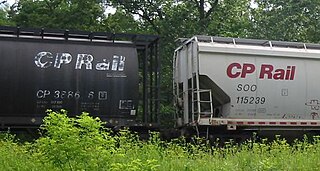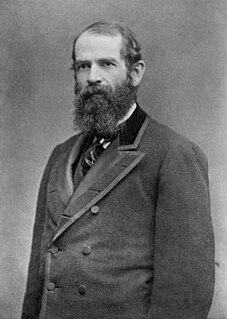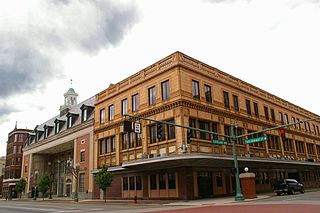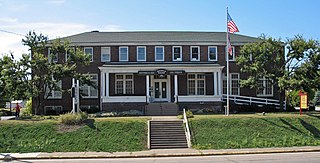
The New York Central Railroad was a railroad primarily operating in the Great Lakes region of the United States. The railroad primarily connected greater New York and Boston in the east with Chicago and St. Louis in the Midwest along with the intermediate cities of Albany, Buffalo, Cleveland, Cincinnati, and Detroit. New York Central was headquartered in New York City's New York Central Building, adjacent to its largest station, Grand Central Terminal.
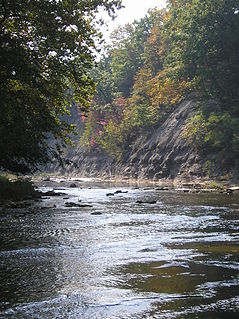
The Huron River is a 14.9-mile-long (24.0 km) waterway in the north central Ohio in the United States. The watershed drains large portions of Erie County and Huron County, the northeast corners of Seneca County and Crawford County, and northern portions of Richland County.
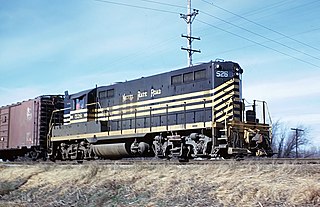
The New York, Chicago and St. Louis Railroad, abbreviated NYC&St.L, was a railroad that operated in the mid-central United States. Commonly referred to as the Nickel Plate Road, the railroad served a large area, including trackage in the states of New York, Pennsylvania, Ohio, Indiana, Illinois and Missouri. Its primary connections included Buffalo, Chicago, Cincinnati, Cleveland, Indianapolis, St. Louis, and Toledo.

The Norfolk and Western Railway was a US class I railroad, formed by more than 200 railroad mergers between 1838 and 1982. It was headquartered in Roanoke, Virginia, for most of its existence. Its motto was "Precision Transportation"; it had a variety of nicknames, including "King Coal" and "British Railway of America" even though the N&W had mostly articulated steam on its roster. During the Civil War, the N&W was the biggest railroad in the south and moved most of the products with their steam locomotives to help the South the best way they could.
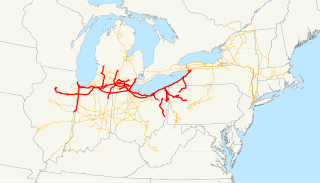
The Lake Shore and Michigan Southern Railway, established in 1833 and sometimes referred to as the Lake Shore, was a major part of the New York Central Railroad's Water Level Route from Buffalo, New York, to Chicago, Illinois, primarily along the south shore of Lake Erie and across northern Indiana. The line's trackage is still used as a major rail transportation corridor and hosts Amtrak passenger trains, with the ownership in 1998 split at Cleveland between CSX to the east, and Norfolk Southern in the west.

The Wheeling and Lake Erie Railway is a Class II regional railroad that provides freight service, mainly in the U.S. state of Ohio. It took its name from the former Wheeling and Lake Erie Railway, most of which it bought from the Norfolk and Western Railway in 1990.
The Cleveland Short Line Railway is a freight bypass around southern Cleveland, Ohio, in the United States. A quasi-independent railroad organized by major shareholders of the Lake Shore and Michigan Southern Railway, the shortline was intended to allow the Lake Shore and Michigan Southern to bypass the congested railroads in downtown Cleveland. The Cleveland Short Line has had a succession of owners, and is currently part of CSX Transportation.

The Akron, Canton and Youngstown Railroad was a Class I railroad which operated in the state of Ohio. The company was founded in 1907 and opened its mainline between Mogadore and Akron, Ohio in 1912. Later reclassified as a short-line railroad, the company was bought by the Norfolk and Western Railway in 1964 and merged in 1982. Despite the name, the company served neither Canton nor Youngstown.
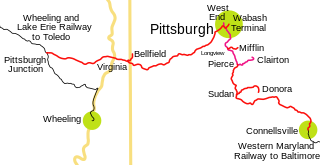
The Pittsburgh and West Virginia Railway was a railroad in the Pittsburgh, Pennsylvania and Wheeling, West Virginia, areas. Originally built as the Wabash Pittsburgh Terminal Railway, a Pittsburgh extension of George J. Gould's Wabash Railroad, the venture entered receivership in 1908 and the line was cut loose. An extension completed in 1931 connected it to the Western Maryland Railway at Connellsville, Pennsylvania, forming part of the Alphabet Route, a coalition of independent lines between the Northeastern United States and the Midwest. It was leased by the Norfolk and Western Railway in 1964 in conjunction with the N&W acquiring several other sections of the former Alphabet Route, but was leased to the new spinoff Wheeling and Lake Erie Railway in 1990, just months before the N&W was merged into the Norfolk Southern Railway.
In the "Official Territory", the land of the Northeast U.S. bounded roughly by the Mississippi, Ohio and Potomac rivers, one of the most important railroad corridors is between New York City and Chicago. For over a century, this corridor was dominated by four major railroads, and an aggregate of other roads that served as a fifth option.
In addition to streetcar lines, the Van Sweringen Brothers of Cleveland, Ohio owned a vast network of steam railroads.

Cleveland has been and continues to be deeply rooted in railroad history.

The Toledo, St. Louis and Western Railroad, often abbreviated TStL&W and commonly known as the Clover Leaf, was a railroad company that operated in northwestern Ohio, north central Indiana, and south central Illinois during the late 19th and early 20th centuries.
The Flats Industrial Railroad is a Class III railroad that provides short-line commercial/industrial switching service in Cleveland, Cuyahoga County, Ohio, primarily with CSX Transportation and the Norfolk Southern Railway.
Wheeling and Lake Erie Railway may refer to:
The Ashland Railway is a Class III railroad shortline railroad operating within North Central Ohio and based in Mansfield, Ohio. Since its inception in 1986, Ashland Railway has grown to provide service 24 hours a day 7 days a week along 55 miles of track in two segments, to industries within Ashland, Huron, Richland and Wayne counties. ASRY interchanges with the Norfolk Southern Railway in Mansfield, the Wheeling & Lake Erie Railway in Plymouth and CSX Transportation (CSXT) in Willard. The line runs southeast from Willard through Plymouth and Shelby, to Mansfield. From Mansfield the line runs northeast through Ashland and terminates in West Salem.
The Cleveland Commercial Railroad (CCR) is a shortline railroad which operates in Cuyahoga County in Ohio in the United States. Founded as a freight-only railroad in 2004, it leases and has trackage rights on lines owned by the Norfolk Southern and the Wheeling and Lake Erie Railway. It also operates an industrial switching railroad at the Port of Cleveland.

The Valley Railway was a shortline railroad which operated between the city of Cleveland and small town of Zoarville in the state of Ohio in the United States. The railroad was founded in 1871, but the first segment of track did not open until 1880 and the line was not completed until 1884. The Baltimore and Ohio Railroad (B&O) obtained a controlling interest in the Valley Railway in 1890. The railroad went bankrupt in 1895, at which time it was reorganized as the Cleveland, Terminal and Valley Railway (CT&V). The B&O took over operation of the CT&V in 1909, and the company was merged with the B&O in 1915.
